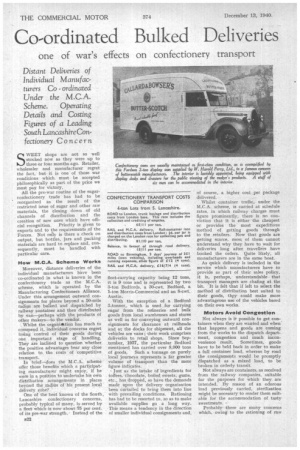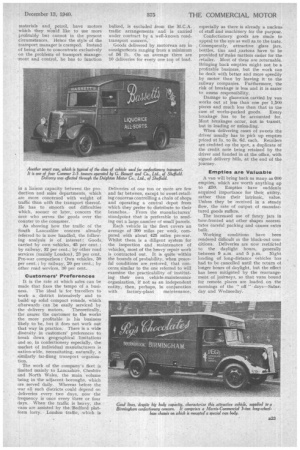Co-ordinated Bulked Deliveries
Page 28

Page 29

If you've noticed an error in this article please click here to report it so we can fix it.
one of war's effects on confectionery transport
Distant Deliveries of Individual Manufacturers Co ordinated Under the M.C.A. Scheme, Operating Details and Costing Figures of a Leading South Lancashire Confectionery Concern SWEET shops are not so well stocked now as they were up to three or four months ago. Retailer, wholesaler and manufacturer regret the fact, but it is one of those war conditions which, must be accepted philosophically as part of the price we must pay for victory.
All the pre-war routine of the sugarconfectionery trade has had to be reorganized as the result of the restricted issue of sugar and other raw materials, the closing down of old channels of distribution and the creation of new ones which have offi cial recognition. Priority is given to exports and to the requirements ,of the Forces. Not only is there a check on output, but bottles, jars and packing materials are hard to replace and, consequently, must be handled with particular care.
How M.C.A. Scheme Works Moreover, distance deliveries of the individual manufacturers have been co-ordinated in what is known in the confectionery trade as the M.C.A. scheme, which is operated by the Manufacturing Confectioners Alliance. Under this arrangement outward consignments for places beyond a 50-mile radius are bulked and dispatched by railway container and then distributed by van—perhaps with the products of other makers—to the vendor.
Whilst the organiatition has much to commend it, individual concerns regret losing control of their goods during' one important stage of handling. They are inclined to question whether the positive advantages bear any close relation to the costs of competitive transport. . In brief—does the M.C.A. scheme Offer those benefits which a participating manufacturer might enjoy, if he were in a position to undertake his own distribution arrangements in places beyond the radius of his present loCal delivery zone? ' . • .
One of the best known of the South, Lancashire confectionery concerns, probably typical of many, is served by a fleet which is now about 75 per cent. of its pre-war strength.' Instead of the fleet-carrying capacity being 12 tons, it is 9 tons and is represented by two 3-ton Bedfords, a 30-cwt. Bedford, a 1.-ton Morris-Commercial and an 8-cwt. Austin.
With the exception of a Bedford 3-tormer, which is used for carrying sugar from the refineries and bulk goods from local warehouses and stores as well as for conveying outward consignments for clearance at railheads and at the docks for shipment, all the vehicles are vans; their work comprises deliveries to retail shops. Since September, 1937, the particular Bedford mentioned has carried over 8,000 tons of goods.. Such a tonnage on purely local journeys represents a far greater volume of transport 'than the mere figure indicates.
Just as the intake of ingredients for toffees, chocolate, boiled sweets, gums, etc., has dropped, so have the demands made upon the delivery organization been curtailed to bring them into line with prevailing conditions. Rationing has had to be resorted to, so as to make available supplies go a long way. This means a tendency in the direction of smaller individual consignments and, of course, a higher cost . per package delivered.
Whilst container traffic, under the M.C.A. scheme, is carried at schedule rates, in which railway charges must figure prominently, there is no conviction that it is either the cheapest or provides the most expeditious method of getting goods through to the retailers. Now that goods are getting scarce, most of them cannot understand why they have to wait for deliveries long after travellers have booked the orders. Quite likely, all manufacturers are in the same boat.
As quick delivery is included in the service which manufacturers have to provide as part of their sales policy. it is, perhaps, understandable that transport manager's are chafing at the bit. It is felt that if left to select the method of distribution best suited to their goods, they could make more advantageous use of the vehicles based on their own works.
Motors Avoid Congestion
Not always is it possible to get containers when they are wanted and when that happens and goods are coming from the works to the dispatch department, congestion and much inconvenience result. Sometimes, goods have to be held back in order to make a full container load, whereas by road the consignments would be promptly dispatched as a mixed load, to be broken in orderly transit.
Not always are containers, as received from the railway companies, suitable for the purposes for which they are intended. By reason of an odorous load previously carried, sterilization might be necessary to render them suitable for the accommodation of tasty sweetmeats. • Probably there are many concerns which, owing to the rationing of raw materials and petrol, have motors which they would like to use more profitably but cannot in the present circumstances. Hence the style of the transport manager is cramped. Instead of being able to concentrate exclusively on the problems of transport management and control, he has to function in a liaison capacity between the production and sales departments, which are more concerned with weight of traffic than with the transport thereof. He has to smooth out difficulties which, sooner or later, concern the man who serves the goods over the counter to the consumer.
As showing how the traffic of the South Lancashire concern already referred to is now handled, the following analysis is of interest: Goods, carried by own vehicles, 45 per cent. ; by railway, 32 per cent.; by other road services (mainly London), 23 per cent. Pre-war comparison; Own vehicles, 50 per cent. ; by railway, 20 per cent.; by other road services, 30 per cent.
Customers' Preferences It is the rate at which sales can be made that fixes the tempo of a busi ness. The ideal is for travellers to work a district intensively and to build' up solid compact rounds, which afterwards can be easily serviced by the -delivery motors. Theoretically, the nearer the customer to the works the more profitable is his business likely to be, but it does not work out that way in practice. There is a wide diversity in customers' preferences to break down geographical limitations and so, in confectionery especially, the market of individual manufacturers is nation-wide, necessitating, naturally, a similarly far-flung transport organization.
The work of the company's fleet is limited mainly to Lancashire, Cheshire and North Wales, the main volume being in the adjacent boroughs, which are served daily. Whereas before the war all such districts could depend on deliveries every two days, now -the frequency is once every three or four • days. When the traffic is heavy, the vans are assisted' by the Bedford platform lorry. London traffic, which is bulked, is excluded from the M.C.A. traffic arrangements and is carried under contract by a well-known roadtransport concern.'
Goods delivered by motorvan are in consignifients ranging from a minimum of 56 lb. On an average there are 10 deliveries for every one ton of load.
Deliveries of one ton or more are few and far between, except to' sweet-retailing concerns controlling a chain of shops and operating a central depot from which they prefer to distribute to their branches.. From the manufacturers' standpoint that is preferable to sending out a large number of small parcels.
Each vehicle in the fleet covers an average of :100 miles per week, compared with about 425 miles pre-war. Whilst there. is a diligent system for the inspection and maintenance of vehicle; most of the heavy repair work is contracted out. It is quite within the bounds of probability, when peaceful conditions are restored, that concerns similar to the one referred to will examine the practicability of instituting their own vehicle-maintenance organization, if not as an independent entity, then, perhaps, in conjunction with factory-plant maintenance, especially as there is already a nucleus of staff and machinery for the purpose.
Confectionery goods are made to appeal to the eye as well as to the taste. Consequently, attractive glass jars, bottles, tins and ,cartons have to be provided td make matters easier for the retailer. Most of these are returnable. Bringing back empties might not be a profitable business, but the work can be dealt with better and more speedily by motor than by leaving it to the railway companies. Furthermore, the risk of breakage is less and it is easier to assess responsibility.
Damage to glassware carried by van works out at less than one per 1,500 pieces and much less than that in the case of works-packed goods. Every breakage has to be accounted for. Most breakages occur, not in transit; but in loading or unloading.
When delivering cases of sweets the driver usually has to pick up empties Priced at Is. to 3s. 6d. each. Retailers are credited on the spot, a duplicate of the credit note being retained by the driver and handed in at the office, with signed delivery bills, at the end of the journey. Empties are Valuable A van will bring back as many as 600 empties, which are worth anything up to 250. Empties have suddenly acquired importance for their utility, rather than their intrinsic, value. Unless they be received in a steady flow, the rate of output of manufactured goods suffers.
The increased use of fancy jars in bow-fronted and other shapes necessitates careful packing and causes extra bulk.
Working conditions have been rendereddifficult in the black-out conditions. Deliveries are now restricted to the daylight hours, generally
between 9 am. and 5 p.m. Night loading of long-distance vehicles has had to be cancelled until the return of longer hours of daylight, but the effect has been mitigated by the rearrangement of journeys, so that vans bound for remote places are loaded, on the mornings of the "off " .days—Saturday and Wednesday.




























































